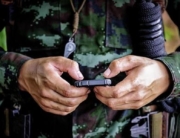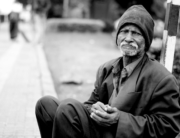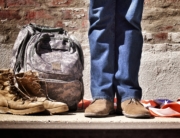by Eric Lindberg
Physical injuries and the psychological effects of war can have devastating consequences on the sexual functioning of service members and veterans.
Despite recent advances in protective gear, members of the U.S. military face a serious risk of genital injuries due to improvised explosives and other unique aspects of the wars in Afghanistan and Iraq. Psychosocial challenges, such as post-traumatic stress disorder and depression, can also exacerbate issues with sexual functioning and libido.
A new study led by the USC School of Social Work’s Center for Innovation and Research on Veterans and Military Families (CIR) is among the first to directly address the topic, which has been plagued by stigma and a relative lack of attention until recent years.
“It’s always hard to get people to talk about sex and problems with sex,” said Sherrie Wilcox, a research assistant professor who is leading the project. She noted military personnel may be even less willing to open up about problems with sexual functioning.
“They have a certain culture that they are used to living with. There’s definitely stigma around the issue.”
Funded by a $650,000 gift from the Iraq Afghanistan Deployment Impact Fund via the California Community Foundation, the 18-month project will involve gathering data about the scope of the problem through literature reviews and surveys with veterans and service members. Insight from that process will inform a training toolkit with resources for social workers and behavioral health professionals, as well as a policy report with specific recommendations for federal officials and veterans’ organizations.
Although previous research is very limited, Wilcox and her research team found estimates that between 5% and 25% of recent veterans report issues with sexual functioning. An estimated 1,500 service members have experienced genital injuries, including infection caused by pulverized sand embedded in the groin area or mutilation caused by projectiles and other explosive devices.
Anthony Hassan, director of CIR and an Air Force veteran, said the relationship between physical injuries and sexual functioning has emerged as a critical issue for service members returning home from conflicts in the Middle East.
“It’s a more common injury in these wars because of the use of improvised explosive devices for ground troops who are walking and patrolling,” he said. “It’s not unique to these wars, but there is more prevalence because of the types of weapons, as well as advances in battlefield treatment.”
Problems linked to these injuries can be extensive, including diminished sexual function, infertility, loss of libido, chronic pain and urinary dysfunction. Although protective equipment for the groin is available to military personnel, compliance has reportedly been an issue due to discomfort.
“For the traditional Army or Marine Corps infantryman, it’s just another five pounds, it’s in the way, it makes you less mobile,” Hassan said.
He said there are efforts underway to redesign the gear, which includes a thinner garment worn at all times and a heavier material used for soldiers on foot patrol. Regardless, the equipment is largely designed to protect against debris from a blast rather than a direct explosion, and serious injuries remain a distinct possibility.
Beyond physical disfigurement, the psychological scars of war often disrupt sexual functioning and have negative effects on general quality of life. Wilcox said issues such as depression and trauma-related stress can affect sexual performance, which can exacerbate those same psychological problems, creating a negative cycle that damages relationships with spouses and significant others.
In addition to reaching out to reconstructive surgeons and contacts at military hospitals to locate those with physical injuries, the research team plans to conduct a survey with community-dwelling veterans to gain a better understanding of how sexual issues are perceived by military personnel in general. That information will inform a training toolkit focused on the most critical issues related to sexual functioning, as well as guidance for professionals on how to broach the topic with clients.
“It’s really about finding the best way for a clinician to start the conversation,” Wilcox said.
The toolkit, which will feature video vignettes, case scenarios, resources and assessment tools, will be embedded as a module in a course on human sexuality offered to master’s students at the USC School of Social Work beginning next year.
“The objective is to educate providers so they at least know how to do an assessment and be able to make appropriate referrals or know what treatment models and interventions are available,” said Doni Whitsett, a clinical professor and licensed social worker who teaches the course. “The educational component will also raise the awareness of social workers and sensitize them to the psychological and social issues of blast injuries.”
The toolkit will be offered to behavioral health care professionals, social work scholars and researchers, and other professionals who work with military populations. The research team plans to hold a short training conference to raise awareness of the issue and disseminate materials developed during the study.
Another significant component of the project is an effort to advocate for change at a policy level. For instance, Hassan said there is concern that Veterans Health Affairs is not providing advanced treatments for veterans who have suffered injuries to their reproductive and urinary tract systems, such as in vitro fertilization and counseling for spouses. Although health care insurance for injured service members covers some fertility care, it doesn’t pay for embryo implantation or specialized care for spouses in most cases, he said.
A policy report by the research team will address these and other critical issues that arise during the study and offer recommendations for federal policy makers on how to improve treatment and support for military personnel who face problems with sexual functioning.
Nancy Berglass, director of the Iraq Afghanistan Deployment Impact Fund (IADIF), said the absence of reliable research and data on the topic, as well as the stigma associated with discussing it, inspired the gift. The $650,000 grant is one of approximately 60 made by the fund, which has distributed nearly $250 million to various efforts to address issues faced by service members and veterans.
“IADIF is the largest philanthropic intervention in the lives of service members, veterans, and their families ever known in this country,” Berglass said of the fund, which was established in 2006 by a then-anonymous donor.
Berglass and the donor felt CIR was well positioned to address issues surrounding sexual functioning among service members and veterans.
“CIR is an excellent choice to lead this project because of its equal reach into the world of veterans, military families, policy, academia and the community,” she said. “Moreover, having access to leading subject-matter experts at the university makes this a very dynamic and doable project for CIR.”
This article also appeared on the USC School of Social Work news site.








